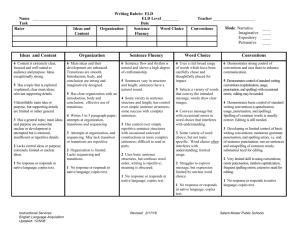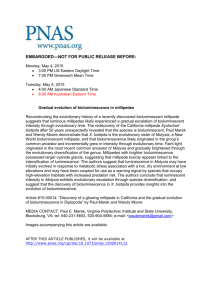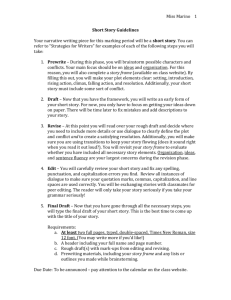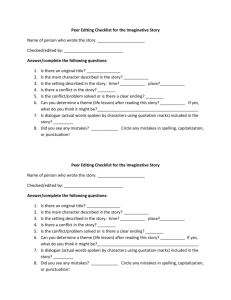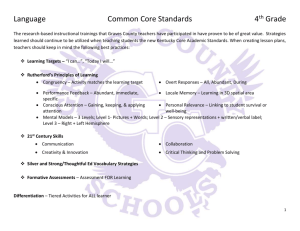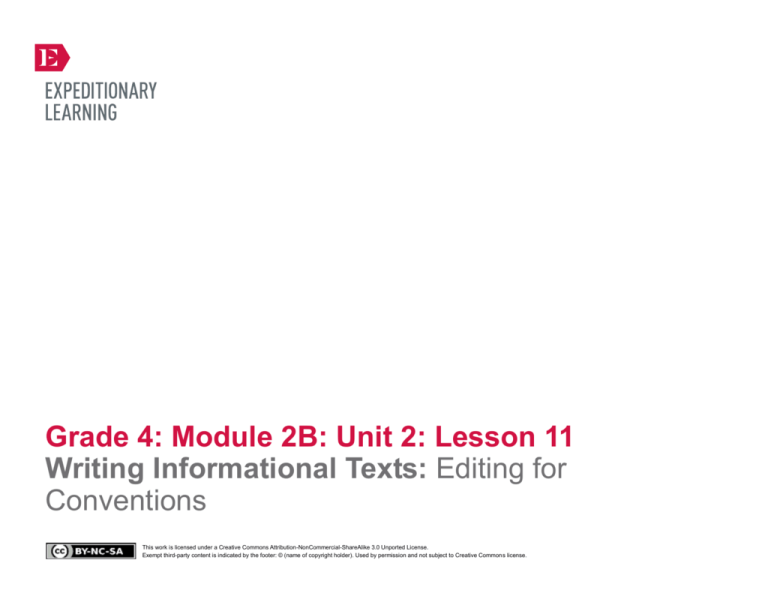
Grade 4: Module 2B: Unit 2: Lesson 11
Writing Informational Texts: Editing for
Conventions
This work is licensed under a Creative Commons Attribution-NonCommercial-ShareAlike 3.0 Unported License.
Exempt third-party content is indicated by the footer: © (name of copyright holder). Used by permission and not subject to Creative Commons license.
GRADE 4: MODULE 2B: UNIT 2: LESSON 11
Writing Informational Texts:
Editing for Conventions
Long-Term Targets Addressed (Based on NYSP12 ELA CCLS)
With support from peers and adults, I can use the writing process to produce clear and coherent writing. (W.4.5)
I can correctly use homophones (e.g., to, too, two; there, their). (L.4.1g)
I can use correct capitalization in my writing. (L.4.2a)
I can spell grade-appropriate words correctly. (L.4.2d)
I can use resources to check and correct my spelling. (L.4.2d)
Supporting Learning Targets
Ongoing Assessment
• I can check my peers’ work for correct capitalization.
• Edits of informative piece
• I can check my peers’ work for correct spelling.
Copyright © 2013 by Expeditionary Learning, New York, NY. All Rights Reserved.
NYS Common Core ELA Curriculum • G4:M2B:U2:L11 • June 2014 • 1
GRADE 4: MODULE 2B: UNIT 2: LESSON 11
Writing Informational Texts:
Editing for Conventions
Agenda
Teaching Notes
1. Opening
• This lesson focuses on helping students edit their informative piece drafts for conventions. In particular,
they focus on spelling, capitalization, and homophones.
A. Engaging the Writer: Whip-around (5 minutes)
B. Reviewing Learning Targets (5 minutes)
2. Work Time
A. Guided Practice: Editing for Conventions (15
minutes)
B. Guided Practice: Editing for Homophones (10
minutes)
C. Editing Stations (20 minutes)
3. Closing and Assessment
A. Debrief (5 minutes)
4. Homework
A. Continue reading your independent reading book
for this unit.
• Before students complete edits on their own drafts, the teacher guides them through the process. To do
this, two editing stations are created: one for spelling and one for capitalization. As in previous lessons,
the teacher models how to make edits based on the Millipede Informative Piece Draft. (Note that the
Millipede Informative Piece Draft with Revisions in the supporting materials provides example
revisions.) Then, students are released to visit the editing stations and work with a partner to improve
their drafts.
• Students are also guided through a mini lesson on homophones and work with a partner to create
example sentences using homophones.
• At the end of the lesson, collect students’ most recent informative piece drafts, with their revisions from
Lesson 10 and edits from this lesson. Students will publish their informative pieces in Lesson 2 of Unit
3; use the time in between this lesson and Unit 3, Lesson 2 to read and give feedback to students on
their writing.
• If your district has printed lessons for you in black and white, it may be helpful to view this lesson in
color. Go to EngageNY.org or commoncoresuccess.elschools.org and search for 4th grade, Module 2B,
Unit 2 lessons.
• In advance:
– Set up editing stations. Ideally these stations will have enough room for about half of your class to sit.
Students should be able to see the Spelling Conventions and Capitalization Conventions anchor
charts, have access to colored pencils (designate one color for spelling mistakes and one color for
capitalization mistakes and place these at the appropriate stations) and have a surface to write on
(table/desks or clipboards).
– Review the Millipede Informative Piece Draft and make changes if necessary, based on the needs of
your class.
• Post: Spelling Conventions and Capitalization Conventions anchor charts; learning targets.
Copyright © 2013 by Expeditionary Learning, New York, NY. All Rights Reserved.
NYS Common Core ELA Curriculum • G4:M2B:U2:L11 • June 2014 • 2
GRADE 4: MODULE 2B: UNIT 2: LESSON 11
Writing Informational Texts:
Editing for Conventions
Lesson Vocabulary
Materials
spelling, homophone, capitalization,
publish
• Spelling Conventions anchor chart (new; co-created with students during Work Time A)
• Capitalization Conventions anchor chart (new; co-created with students during Work Time A)
• Millipede Informative Piece Draft (one for display)
• Millipede Informative Piece Draft with Revisions (for teacher reference)
• Colored pencils (one of each color per student)
• Common Affixes handout (from Unit 1, Lesson 12; one per student and one to display)
• Informative piece drafts (one per student)
Meeting Students’ Needs
Opening
A. Engaging the Writer: Whip-around (5 minutes)
• Review the Whip-around protocol with students. Using this protocol, ask:
* “What is one supporting detail or word choice revision you are proud of from the last lesson?”
• Validate student responses and summarize what they were proud of. This may sound something like:
* “Great revisions! I heard several of you say that you added the definition of the word predator to your writing.”
B. Reviewing Learning Targets (5 minutes)
• Remind students that they have been working through the writing process to write an informational text. Ask them which
parts of the writing process they have completed so far.
• Discussing and clarifying the
language of learning targets helps
build academic vocabulary.
• Listen for them to share that they have planned, drafted, and revised their pieces.
• Direct students’ attention to the learning targets and read them aloud:
* “I can check my peers’ work for correct capitalization.”
* “I can check my peers’ work for correct spelling.”
• Tell students that today they will move to the editing stage of the writing process and will edit their informative pieces for
the conventions listed in the supporting targets. Circle the key words: spelling and capitalization. Clarify the meanings of
these words or targets as needed.
Copyright © 2013 by Expeditionary Learning, New York, NY. All Rights Reserved.
NYS Common Core ELA Curriculum • G4:M2B:U2:L11 • June 2014 • 3
GRADE 4: MODULE 2B: UNIT 2: LESSON 11
Writing Informational Texts:
Editing for Conventions
Work Time
Meeting Students’ Needs
A. Guided Practice: Editing for Conventions (15 minutes)
• Point out the two editing stations. Read the Spelling Conventions anchor chart at the first station:
• Anchor charts provide a visual cue
to students about what to do when
you ask them to work
independently. They also serve as
note-catchers when the class is coconstructing ideas.
* “How can I make sure my SPELLING is correct?”
• Cold call students to share out their responses to question on the Spelling Conventions anchor chart and record their
responses on the anchor chart.
• Circle or add important tips for this question. Be sure these are on the chart: breaking down words using prefixes and
suffixes, checking the research journal glossaries or research texts, and thinking about whether the word is a common
homophone. Explain that you will discuss homophones in more depth later in the lesson.
• Repeat this process for capitalization, asking the question:
* “How do I know if my CAPITALIZATION is correct?”
• Be sure to note that students’ expert group animal is not a proper noun and should not be capitalized. Record student
responses on the Capitalization Conventions anchor chart.
• Tell students that they will use these conventions anchor charts later in the lesson.
• Display the Millipede Informative Piece Draft. Use the first few sentences of the draft to model, referring to the
Millipede Informative Piece Draft with Revisions (for teacher reference) as needed. Demonstrate how to edit for
each convention by circling or underlining with the correct colored pencil (see Teaching Notes). Be sure to model referring
to the Spelling Conventions and Capitalization Conventions anchor charts posted at each editing station as resources, and be
sure to model spelling mistakes in affixes and homophones.
• For example: Read aloud the Millipede Informative Piece Draft. Notice a mistake and think aloud by saying something like:
* “I notice that one of the rules for capitalization is to be sure the first word of each sentence is capitalized.”
• Then, demonstrate fixing a mistake. Say:
* “I see that I did not do this when I wrote the second sentence, so I am going to circle it with a colored pencil from this
station.”
Copyright © 2013 by Expeditionary Learning, New York, NY. All Rights Reserved.
NYS Common Core ELA Curriculum • G4:M2B:U2:L11 • June 2014 • 4
GRADE 4: MODULE 2B: UNIT 2: LESSON 11
Writing Informational Texts:
Editing for Conventions
Meeting Students’ Needs
Work Time (continued)
• Continue modeling, and reading aloud the Millipede Informative Piece Draft. Notice another mistake and think aloud by
saying something like:
* “I notice that one hint is to think about if the word has any common prefixes or suffixes.”
• Then, demonstrate fixing the mistake. Say:
* “I’m not sure if I spelled the word ‘decaying’ right in this sentence in the first paragraph: ‘They roll into balls and eat
leaves or decayin vegetation.’ I think it ends with a suffix. I’m going to look at my Common Affixes handout from Unit
1, Lesson 12 and check to see if there’s a suffix on here that I hear in the word ‘decaying.’ On that handout, I see the suffix
–ing! That’s how the word ‘decaying’ ends. I’ll circle ‘decayin’ on my draft with a colored pencil from this station and write
‘-ing’ above it.”
• Address any clarifying questions.
B. Guided Practice: Editing for Homophones (10 minutes)
• Explain that homophones are words that sound the same but have different meanings and usually different spellings.
• Ask students to brainstorm some common homophones and ask for volunteers to share out.
• Record their responses on the Spelling Conventions anchor chart by that bullet point. Record homophones such as:
– two, to, too
– they’re, their, there
– ant, aunt
– ate, eight
– be, bee
– dear, deer
• Consider creating groups or
partnerships in advance rather than
allowing students to choose
partners.
• For students who struggle with
following multiple-step directions,
consider displaying these directions
using a document camera or
interactive white board. Another
option is to type up these
instructions for students to have in
hand.
– for, four, fore
– heard, herd
– its, it’s
– tail, tale
– your, you’re
Copyright © 2013 by Expeditionary Learning, New York, NY. All Rights Reserved.
NYS Common Core ELA Curriculum • G4:M2B:U2:L11 • June 2014 • 5
GRADE 4: MODULE 2B: UNIT 2: LESSON 11
Writing Informational Texts:
Editing for Conventions
Meeting Students’ Needs
Work Time (continued)
• Choose one of the common homophones suggested by students and invite them to work with a partner to write two
sentences. Explain that each sentence should include one of the homophones. Provide an example if necessary.
• Give them 2 minutes to work and then use equity sticks to call on students to share their sentences whole class. An example
might be: “The ant climbed up the log” and “My aunt visited for dinner last night.”
• Next, ask students to rewrite their sentences, replacing the correct homophone with the incorrect homophone.
• Ask students to read their sentences aloud to their partner and discuss how the meaning of their sentences changed.
• Give them 2 minutes and then use equity sticks to call on students to share their new sentences whole class, and how the
meaning of their sentences changed. Listen for responses like: “My new sentence is: The aunt climbed up the log. The
meaning changed because in my original sentence, it meant an insect climbed up a log but in the new sentence, it meant a
person climbed up a log.”
• Ask:
* “Why is it important to be sure to use the correct homophone in our writing?”
• Listen for responses like: “so our reader is not confused” or “so our writing is accurate.”
• Model revising a spelling mistake for a homophone in the Millipede Informative Piece Draft. Notice a mistake and think
aloud by saying something like:
* “I notice that one hint is to think about if the word is a homophone.”
• Then, demonstrate fixing a mistake. Say:
* “I know that two, to, and too are homophones, and I see that I used ‘too’ in this sentence in the first paragraph: ‘They have
twenty to one hundred body segments, and too pairs of legs on each segment.’ I’m going to think about what ‘too’ means
and if I used the right spelling here. In my writing, I mean the number two, but I know that ‘too’ means ‘also.’ So I need to
fix the spelling of that word. I’ll circle it on my draft with a colored pencil from this station and write ‘two’ above it.”
• Address any clarifying questions.
Copyright © 2013 by Expeditionary Learning, New York, NY. All Rights Reserved.
NYS Common Core ELA Curriculum • G4:M2B:U2:L11 • June 2014 • 6
GRADE 4: MODULE 2B: UNIT 2: LESSON 11
Writing Informational Texts:
Editing for Conventions
Work Time (continued)
Meeting Students’ Needs
C. Editing Stations (20 minutes)
• In addition to the Conventions
anchor charts, a conventions
checklist can be prepared
beforehand to support ELLs or
students with special needs during
editing.
• Tell students that they are going to go to both editing stations to get help from peers to improve their informative piece
drafts. Give directions:
1. Count off or choose one station to begin work.
2. Take your informative piece draft with you to your first station.
3. At that station, trade papers with a partner.
4. Read your partner’s draft (with revisions for supporting details and vocabulary from Lesson 10) and identify any
convention mistakes related to the topic at that station’s chart.
5. When both partners are finished, move to the next station.
6. Be sure to get to both stations.
• Dismiss students to the stations.
• Circulate and confer with pairs who may need extra support. Be sure that all students get to both stations. After about 10
minutes, remind them to rotate to the other station. Pairs that finish early can begin revising and typing, if these facilities are
available.
• Consider several options if students
need more structured management
of movement. Partners can raise
their hands when they are done at a
given station and check with you
before they move on. Or students
can remain in one place and all
materials can be available where
they are working.
• At the end of the lesson, collect students’ most recent informative piece drafts.
Copyright © 2013 by Expeditionary Learning, New York, NY. All Rights Reserved.
NYS Common Core ELA Curriculum • G4:M2B:U2:L11 • June 2014 • 7
GRADE 4: MODULE 2B: UNIT 2: LESSON 11
Writing Informational Texts:
Editing for Conventions
Closing and Assessment
Meeting Students’ Needs
A. Debrief (5 minutes)
• Gather students whole group.
• Developing self-assessment and
reflection supports all learners, but
research shows it supports
struggling learners most.
• Redirect their attention to the learning targets and read them aloud.
• Tell students that they have learned a lot over the last couple weeks about researching and writing informational texts by
writing an informational page about their expert group animal. Tell them that in the next lesson, they will be assessed on the
focus question listed at the top of their Informative Page Planning graphic organizer: “How does my expert group animal use
its body and behaviors to help it survive?” To do this, they will do an on-demand assessment in which they write another
informational piece about animal defense mechanisms for a different animal.
• Assure them that they are ready for this “on my own” assessment. They have just finished their informational pages about
their expert group animals and now should be experts on this genre of writing.
Homework
Meeting Students’ Needs
• Continue reading your independent reading book for this unit.
Copyright © 2013 by Expeditionary Learning, New York, NY. All Rights Reserved.
NYS Common Core ELA Curriculum • G4:M2B:U2:L11 • June 2014 • 8
Grade 4: Module 2B: Unit 2: Lesson 11
Supporting Materials
This work is licensed under a Creative Commons Attribution-NonCommercial-ShareAlike 3.0 Unported License.
Exempt third-party content is indicated by the footer: © (name of copyright holder). Used by permission and not subject to Creative Commons license.
GRADE 4: MODULE 2B: UNIT 2: LESSON 11
Millipede Informative Piece Draft
(For Teacher Reference)
Teacher directions: This model is to be used during Work Time A; there are conventions mistakes
in it intentionally that are used to model editing. The model following this draft shows edits to be
made during the modeling in Work Time A.
The millipede is a relative of the centipede. they have twenty to one hundred body segments,
and too pairs of legs on each segment. Millipedes like to be in damp areas. In the wild, they live on
moist forest floors. Some millipedes live in our houses! They like to live in bathrooms and basements
because they’re damp. Millipedes aren’t fast. They roll into balls and eat leaves or decayin vegetation.
Their main predators, or animals that hunt and eat the millipede, are ants, toads, and mice. To
protect themselves from predators, millipedes have two main defense mechanisms. When they’re near
a predator, they might roll into a ball or ooze poison.
When a predator is nearby, millipedes often roll into a ball. Because they have so many body
segments, it’s easy for them to bend and roll into a tight ball. They have hard exoskeletons, which
means that their skeletons are on the outside of their bodies; this makes the ball hard
too. That protects the millipede’s body. The ball hides the millipede from predators because it doesn’t
look like a millipede anymore! A toad looking for lunch might easily mistake a tiny rolled up
millipede for a pebble and pass it by! This is a very useful defense mechanism.
Copyright © 2013 by Expeditionary Learning, New York, NY. All Rights Reserved.
NYS Common Core ELA Curriculum • G4:M2B:U2:L11 • June 2014 • 10
GRADE 4: MODULE 2B: UNIT 2: LESSON 11
Millipede Informative Piece Draft
(For Teacher Reference)
Some millipedes use emit poison to protect themselves. They do this when the predator
threatens or touches them. Some poison is sticky. When the poison gets on the predator, it slows
the predator down which gives the slow millipede time to escape. Another poison is gas, and
can be very strong. Some gas is so strong that it can paralyze or kill the predator. Some millipedes
have poison that smells, and when predators smell it they run away. Sometimes, other
animals rub millipedes all over their bodies to use the poison to repel insects. The millipedes don’t
often use their poison, though. They would rather not be attacked in the first place! Millipedes are
very special critters. They have unusual and interesting defense mechanisms that keep them safe from
predators.
Copyright © 2013 by Expeditionary Learning, New York, NY. All Rights Reserved.
NYS Common Core ELA Curriculum • G4:M2B:U2:L11 • June 2014 • 11
GRADE 4: MODULE 2B: UNIT 2: LESSON 11
Millipede Informative Piece Draft with Revisions
(For Teacher Reference)
Teacher directions: This model shows edits to be made during the modeling in Work Time A.
Changes in blue indicate edits for capitalization, and changes in purple indicate edits for spelling.
The millipede is a relative of the centipede. They have twenty to one hundred body segments,
and two pairs of legs on each segment. Millipedes like to be in damp areas. In the wild, they live on
moist forest floors. Some millipedes live in our houses! They like to live in bathrooms and basements
because they’re damp. Millipedes aren’t fast. They roll into balls and eat leaves or decaying
vegetation. Their main predators, or animals that hunt and eat the millipede, are ants, toads,
and mice. To protect themselves from predators, millipedes have two main defense mechanisms.
When they’re near a predator, they might roll into a ball or ooze poison.
When a predator is nearby, millipedes often roll into a ball. Because they have so many body
segments, it’s easy for them to bend and roll into a tight ball. They have hard exoskeletons, which
means that their skeletons are on the outside of their bodies; this makes the ball hard
too. That protects the millipede’s body. The ball hides the millipede from predators because it doesn’t
look like a millipede anymore! A toad looking for lunch might easily mistake a tiny rolled up
millipede for a pebble and pass it by! This is a very useful defense mechanism.
Copyright © 2013 by Expeditionary Learning, New York, NY. All Rights Reserved.
NYS Common Core ELA Curriculum • G4:M2B:U2:L11 • June 2014 • 12
GRADE 4: MODULE 2B: UNIT 2: LESSON 11
Millipede Informative Piece Draft with Revisions
(For Teacher Reference)
Some millipedes use emit poison to protect themselves. They do this when the predator
threatens or touches them. Some poison is sticky. When the poison gets on the predator, it slows
the predator down, which gives the slow millipede time to escape. Another poison is gas, and
can be very strong. Some gas is so strong that it can paralyze or kill the predator. Some millipedes
have poison that smells, and when predators smell it they run away. Sometimes, other
animals rub millipedes all over their bodies to use the poison to repel insects. The millipedes don’t
often use their poison, though. They would rather not be attacked in the first place! Millipedes are
very special critters. They have unusual and interesting defense mechanisms that keep them safe from
predators.
Copyright © 2013 by Expeditionary Learning, New York, NY. All Rights Reserved.
NYS Common Core ELA Curriculum • G4:M2B:U2:L11 • June 2014 • 13


